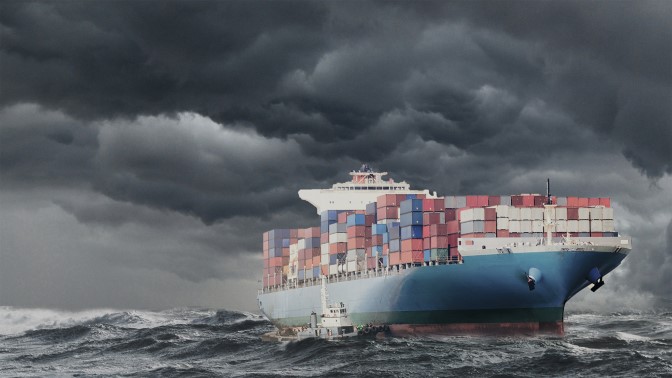-
Tariffs and the rise of protectionism
International trade has been steadily rising at a faster rate than global economic growth since the end of World War II. Yet, 2019 marks the end of this 75-year trend–the equivalent of a massive container ship slowing to a crawl.
Cross-border trade represented 6% of world GDP in 1946; it rose to 23% last year, and in 2019 this ratio is falling. New trade policies initiated by the world’s largest importer of hard goods (the US), together with tariff retaliation and the rise of nationalism and protectionism in several other countries—these are the driving factors behind the end of a seven-decade trend.
If trade continues to stay stalled, the impacts on global economic growth rates could be significant, albeit with meaningful variation by country.

After signaling progress toward resolving the China/US trade dispute, President Trump surprised markets by raising the tariff rate on $200B of Chinese imports to the US from 10% to 25%, effective May 10, and reiterated the potential to extend 25% tariffs to the remaining $325B of imports not currently subject to taxation. This latest increase is in addition to the $50B of imports previously subject to a 25% duty. Moreover, on May 15, the US further raised stakes by issuing an executive order effectively banning US companies from doing business with Huawei, the world’s second largest smartphone maker. And on May 30, the US issued another tariff threat for Mexican imports.
Markets reacted negatively, with the US S&P 500 declining 6.6% and the Shanghai Composite declining 5.8% in May (see page 7). The US yield curve has also inverted (page 12). Unsurprisingly, China retaliated with tariffs on an additional $60 billion of US imports effective June 1 and has threatened to curtail exports of rare earth elements, a key industrial input.
If trade continues to stay stalled, the impacts on global economic growth rates could be significant, albeit with meaningful variation by country. The theory of comparative advantage is among the oldest and best established in classical economics – developed by David Ricardo in 1817. It states that producing goods based on local strengths and resources and trading for other products produces higher global production and wealth. Many economists also acknowledge that the benefits of free trade can be uneven and subject to manipulation by some countries. In other words, unfettered free trade increases the size of the global economic pie—but it does not necessarily lead to larger pie slices for all.
Oxford Economics expects global trade growth to slow to 1.8% in 2019, down from 5% in 2018 and down from an average of 7% annual growth in the last two decades. Although the direct dispute has mainly involved the US and China, many other countries and technology firms will be affected as they export intermediate goods to China, which China will curtail due to declining exports. Countries most exposed to the global trade slowdown include Korea, Taiwan and Germany, while less open economies, such as the US, Brazil and India, are better insulated.
How should real estate investors react to the recent trade news?
- Core real estate, consistent with its low beta profile, will likely be less impacted than most sectors of the economy, as operating buildings have little or no imported inputs. Harsher treatment of off-shore real estate investors vs domestic capital could be a retaliatory risk, but has not yet risen to the top of the saber rattling list.
- Real estate demand will suffer to the extent that GDP and jobs are impacted. Current forecasts are for modest impact on GDP in most countries — erosion of 50bps (or less) growth. A further escalation of the trade war would worsen the impact.
- Tariffs on materials (especially) will modestly increase the cost to deliver new buildings and upgrade existing ones. At the margin, this will reduce new construction and increase the value of existing buildings, although the impact can be muted by currency moves, lower developer profits and lower land costs.
- The warehouse/logistics sector will experience the greatest impact among property types to the extent that tariffs reduce imports of retail products and business equipment. Supply chains will be interrupted if/when the UK leaves the EU or as import substitution occurs in the US as goods from Korea, Japan, Vietnam and Mexico take the place of Chinese-made imports subject to tariffs.
- The cost savings from e-commerce and other technological improvements may offset the rise of tariffs, so that consumers and businesses are not slammed by higher costs, causing final demand to plummet. Within China and India, the fast-growing domestic economies and lack of modern logistics buildings should support the growth of the warehouse sector for the foreseeable future.
In summary, the current US/China trade dispute is a reversal of many decades of free and growing trade between countries. A few observers expect that the dispute will be resolved by the end of the year, although recent actions and remarks by both the US and China create doubts about that outcome. The impact on real estate demand and values should be modest compared to other sectors, although unforeseen consequences are certainly possible.
In addition to this month’s Macro Deck, LaSalle’s Research & Strategy team published four new briefing notes over the last month:
- Completion Strategies for Real Estate: Bringing together authors from LaSalle’s public and private real estate investment team’s, this paper illustrates how institutional investors can use publicly traded real estate securities to efficiently “complete” their real estate allocations by adding niche property types.
- Urbanization Reimagined: In this note, we look beyond the simple story of more tenant demand in urban places and consider how land prices and rents will change in different parts of the metro area going forward.
- Proptech and Predictive Data Analytics are Changing Real Estate Investment: This note expands on our 2019 ISA, examining how predictive data analytics tools and proptech companies could change how we invest, as well as how we seek to see through the hype that surrounds the growing proptech sector.
- The 2018-19 Investable Universe Update (forthcoming): This is LaSalle’s annual review of the size of the professionally-managed stock of investment real estate, whether held by a listed company, a REIT, or a private equity investment pool. Using new estimation techniques, we also rank the top 40 metros in the world in terms of the total value of their income-earning real estate.

Apr 01, 2025
Working backwards: Dealing with unprecedented policy uncertainty
In this period of elevated policy uncertainty, real estate investors should focus on what they can and should do amidst all the noise.




